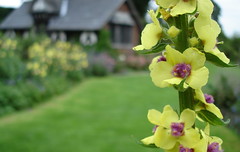 Image by deadmanjones via FlickrAsk the average person whether or not common household cleaners have been tested for safety and they'll most likely tell you of course they have! Unfortunately, this is not true.
Image by deadmanjones via FlickrAsk the average person whether or not common household cleaners have been tested for safety and they'll most likely tell you of course they have! Unfortunately, this is not true.Manufacturers are protected by outdated laws from the 1970s that put corporate profits over human health. Under these old laws, manufacturers don't even have to disclose what chemicals are used in a product's formula.
Given that there are over 80,000 chemicals in the US marketplace today, it is not at all surprising that oversight groups simply can't keep up. Without knowing what chemicals are in a product, every product would need to be tested individually for safety. There are simply too many products on the market to make testing each product individually feasible.
I have been experimenting with non-toxic cleaners for years now, trying to find the products that have known safety and that work best for me and my family. Read on to learn more about my favorite non-toxic cleaning products.
1. Washing soda – Similar to baking soda but more alkaline so it does a better job of cutting through grease, oil and other substances that you might otherwise use toxic solvents to take care of. Look for washing soda in the laundry aisle of your supermarket.
To make a powder dishwasher soap, use two parts washing soda to one part borax.Put the mixture in a covered container with a 1/4 cup mixing cup and use it the next time you run your dishwasher.
2. Baking soda – No list of non-toxic cleaners would be complete without baking soda, also known as sodium bicarbonate. There are many uses for baking soda in the home, everything from tile and grout cleaner to trash can deodorizer and laundry freshener. I like to use baking soda as a non-toxic oven cleaner.
Mix 1 cup baking soda with enough water to form a paste. Use a cleaning brush to rub the paste onto the surfaces of a cooled oven. Leave overnight. The next day, use a clean moistened brush to scrub the baking soda mixture from the surfaces, rinse with water and you’re done!
This method can also be used to clean burnt food from the bottoms of pots and pans.
3. White vinegar – White Vinegar contains about 5% acetic acid, a substance which has been proven to kill mold, viruses and bacteria. Triclosan, the most common antibacterial used in this country, is commonly found even in treated wastewater and is considered by some to be a driving force in the increase in antibiotic-resistant organisms. If you’re looking for a non-toxic antibacterial, white vinegar is your answer!
You can use distilled white vinegar as a cleaner/deodorizer for children's toys as long as they're not stuffed or electronic! Add 1/2 c. vinegar to a bucket of warm water and soak toys for at least an hour. Make sure to rinse thoroughly after soaking. The vinegar scent will disperse as the toys dry.
4. Rubbing alcohol – Rubbing alcohol (isopropyl alcohol) is another great non-toxic disinfectant. I use rubbing alcohol and cotton balls to clean children's toys that I can’t soak in the vinegar mixture above. The best part is that it evaporates very quickly, so it can be used on the fly when you need to clean something fast. Rubbing alcohol is also a great natural polish and build-up remover – pour directly onto a cleaning cloth to polish metal or tile surfaces. Don’t use near ovens or other flammable materials – remember, alcohol can catch on fire!
5. Hydrogen peroxide – Hydrogen peroxide provides all the germ-fighting action of vinegar, but without the strong scent.Use 3% hydrogen peroxide half and half with water in a spray bottle to clean counters, cutting boards and other kitchen surfaces where bacteria may be lurking. You can use the same mixture as a produce wash to remove germs and bacteria.
I use hydrogen peroxide as a non-toxic carpet cleaner, especially for pet urine spots. Make sure to spot test the carpet first if you're going to try this one! Pour 3% hydrogen peroxide directly on the spot you want to clean, let it bubble for a minute or two then blot with a clean towel.
To learn more about the safety of chemicals used in products in the US, visit Safer Chemicals, Healthy Families

No comments:
Post a Comment